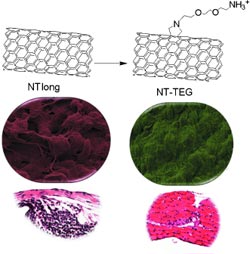It All Depends on the Length

<br>
Carbon nanotubes resemble asbestos fibers in their form. Unfortunately, long, pure nanotubes also seem to have asbestos-like pathogenicity.
In the journal Angewandte Chemie, a European research team has now reported that chemical modifications, for example with tri(ethylene glycol), can alleviate this problem if the modification makes their surface more water-friendly and reduces the effective length of the tubes.
Due to their unique physical, chemical, and electronic properties, carbon nanotubes have become one of the most popular nanomaterials. They are used in electronics, for reinforcing plastics, and in biomedicine as nanotransporters to carry drugs into cells. For many of these applications, particularly in the area of biology, it is necessary to chemically alter the tubes by attaching molecules to their surfaces.
However, the industrial production of carbon nanotubes could bring health risks with it. Studies have shown that multi-walled nanotubes that are more than 20 µm long act like asbestos fibers, causing inflammation followed by granulomas—inflammation-induced knotlike tissue growths. This occurs because the macrophages of our immune system cannot absorb and remove the long fibers. Shorter nanotubes and those with certain surface modifications have now been shown to alleviate toxicity.
A team led by Maurizio Prato, Alberto Bianco, and Kostas Kostarelos wanted to determine what role the chemical modifications have in resolving the toxic risk from the tubes. The scientists from University College London (UK), the CNRS in Strasbourg (France), and the University of Trieste (Italy) attached either hydrocarbon chains or tri(ethylene glycol) chains as side-groups on multi-walled carbon nanotubes and compared their effects to those of unmodified tubes. The results show that the unmodified nanotubes and those with hydrocarbon chains lead to asbestos-like inflammation and granulomas in mice.
However, the carbon nanotubes with tri(ethylene glycol) chains do not.
The difference seems to be a question of aggregation/disaggregation that influences the length of the bundles: As shown by images from transmission electron and atomic force microscopies, the effective length of the tubes is reduced during the reaction that introduces the tri(ethylene glycol) chains.
The researchers believe that the modification with the tri(ethylene glycol) chain breaks apart the tubes from each other so that they interact in the body as shorter, much more hydrophilic individual fibers, whereas both the unmodified tubes and those with apolar hydrocarbons on their surfaces interact with tissue as longer bundles of individual nanotubes.
The researchers conclude that only those modifications that lead to a disentangling of the bundles can alleviate the toxicological problems.
About the Author
Alberto Bianco is Research Director at the French National Center for Scientific Research (CNRS). His research interests focus on the design and development of chemically functionalized carbon nanomaterials for biomedical applications.
Author: Alberto Bianco, CNRS, Institut de Biologie Moléculaire et Cellulaire, Strasbourg (France), mailto:a.bianco@ibmc-cnrs.unistra.fr
Title: Asbestos-like Pathogenicity of Long Carbon Nanotubes Can be Alleviated by Chemical Functionalization
Angewandte Chemie International Edition, Permalink to the article: http://dx.doi.org/10.1002/anie.201207664
Media Contact
More Information:
http://pressroom.angewandte.orgAll latest news from the category: Life Sciences and Chemistry
Articles and reports from the Life Sciences and chemistry area deal with applied and basic research into modern biology, chemistry and human medicine.
Valuable information can be found on a range of life sciences fields including bacteriology, biochemistry, bionics, bioinformatics, biophysics, biotechnology, genetics, geobotany, human biology, marine biology, microbiology, molecular biology, cellular biology, zoology, bioinorganic chemistry, microchemistry and environmental chemistry.
Newest articles

Superradiant atoms could push the boundaries of how precisely time can be measured
Superradiant atoms can help us measure time more precisely than ever. In a new study, researchers from the University of Copenhagen present a new method for measuring the time interval,…

Ion thermoelectric conversion devices for near room temperature
The electrode sheet of the thermoelectric device consists of ionic hydrogel, which is sandwiched between the electrodes to form, and the Prussian blue on the electrode undergoes a redox reaction…

Zap Energy achieves 37-million-degree temperatures in a compact device
New publication reports record electron temperatures for a small-scale, sheared-flow-stabilized Z-pinch fusion device. In the nine decades since humans first produced fusion reactions, only a few fusion technologies have demonstrated…





















